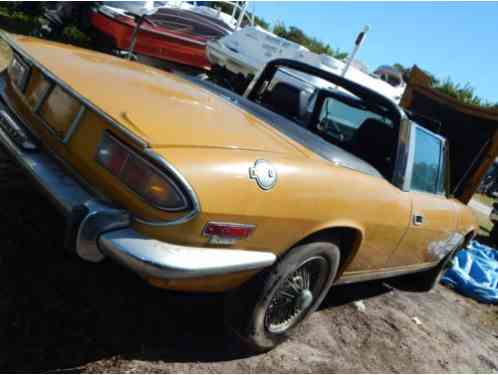Triumph STAG (1971)
for sale
Price: US $3,500.00

Price: US $3,500.00
SOLD AS A Mechanics Special Motor Locked No Rust Florida car barn find stored inside for Many Years Similar to the in movie Diamonds are for ever 007 James Bound Triumph StagFrom Wikipedia, the free encyclopediaTriumph StagOverviewManufacturerTriumph Motor CompanyProduction1970–1977
25, 939 made[1]DesignerGiovanni MichelottiBody and chassisClassSports tourerRelatedTriumph TR250PowertrainEngine3.0L Triumph V8DimensionsWheelbase100 in (2, 540 mm)Length173 in (4, 394 mm)[2]Width63.5 in (1, 613 mm)Height49.5 in (1, 257 mm)
(hardtop)Kerb weight2, 800 lb (1, 300 kg)ChronologyPredecessorTriumph 2000The
Triumph Stag
is a British car sold between 1970 and 1978 by the Triumph Motor Company, styled by Italian designer Giovanni Michelotti.
Contents [hide] 1Design and styling2Engineering3Production4Mk1 and Mk2 Variants5Replacement6Unmade variants7Classic status8Use in popular culture9References10Further reading11External links
Design and styling[edit]Envisioned as a luxury sports car, the Triumph Stag was designed to compete directly with the Mercedes-Benz SL class models. All Stags were four-seater convertiblecoupés, but for structural rigidity – and to meet new American rollover standards of the time – the Stag required a B-pillar roll bar hoop connected to the windscreen frame by a T-bar. A removable hardtop was a popular factory option for the early Stags, and was later supplied as a standard fitment.
The car started as a styling experiment cut and shaped from a 1963–4 Triumph 2000 pre-production saloon, which had also been styled by Michelotti, and loaned to him by Harry Webster, Director of Engineering at Triumph. Their agreement was that if Webster liked the design, Triumph could use the prototype as the basis of a new Triumph model. Harry Webster, who was a long time friend of Giovanni Michelotti, whom he called Micho, loved the design and took the prototype back to England. The end result, a two-door drop head (convertible), had little in common with the styling of its progenitor 2000, but retained the suspension and drive line. Triumph liked the Michelotti design so much that they propagated the styling lines of the Stag into the new T2000/T2500 saloon and estate model lines of the 1970s.
Engineering[edit]1972 StagThe initial Stag design was based around the saloon's 2.5-litre six cylinder engine, but Harry Webster intended the Stag, large saloons and estate cars to use a new Triumph-designed overhead cam (OHC) 2.5-litre fuel injected (PI) V8. Under the direction of Harry Webster's successor, Spen King in 1968, the new Triumph OHC 2.5 PI V8 was enlarged to 2997 cc (3.0 litres) to increase torque. To meet emission standards in the USA, a key target market, the troublesome mechanical fuel injection was dropped in favour of dual Zenith-Stromberg 175 CDSE carburettors. A key aim of Triumph's engineering strategy at the time was to create a family of engines of different size around a common crankshaft. This would enable the production of power plants of capacity between 1.5 and 4 litres, sharing many parts, and hence offering economies of manufacturing scale and of mechanic training. A number of iterations of this design went into production, notably a slant four-cylinder engine used in the later Triumph Dolomite and Triumph TR7, and a variant manufactured by StanPart that was initially used in the Saab 99. The Stag's V8 was the first
update: 2016-02-26
| Condition: | Used | VIN (Vehicle Identification Number): | LE2718LBW |
| Year: | 1971 | Number of Cylinders: | 8 |
| Make: | Triumph | Transmission: | Automatic |
| Model: | STAG | Body Type: | Convertible |
| Trim: | WIRE WHEELS | Warranty: | Vehicle does NOT have an existing warranty |
| Engine: | V8 | Vehicle Title: | Clear |
| Drive Type: | RWD | Options: | Leather Seats |
| Mileage: | 36,000 | Fuel Type: | Gasoline |
| Exterior Color: | Yellow | Disability Equipped: | No |
| Interior Color: | Black |